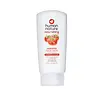What's inside
What's inside
 Key Ingredients
Key Ingredients

 Benefits
Benefits

 Concerns
Concerns

 Ingredients Side-by-side
Ingredients Side-by-side

Water
Skin ConditioningSodium Laureth Sulfate
CleansingGlycerin
HumectantPEG-7 Glyceryl Cocoate
EmulsifyingCocamidopropyl Betaine
CleansingSodium Lactate
BufferingPhenoxyethanol
PreservativePanthenol
Skin ConditioningPEG-120 Methyl Glucose Dioleate
EmulsifyingChlorphenesin
AntimicrobialLactic Acid
BufferingParfum
MaskingDisodium EDTA
Chamomilla Recutita Flower Water
MaskingSodium Hydroxide
BufferingBHT
AntioxidantPEG-40 Hydrogenated Castor Oil
EmulsifyingTrideceth-9
EmulsifyingCI 19140
Cosmetic ColorantDecylene Glycol
Skin ConditioningCI 16035
Cosmetic Colorant1,2-Hexanediol
Skin ConditioningWater, Sodium Laureth Sulfate, Glycerin, PEG-7 Glyceryl Cocoate, Cocamidopropyl Betaine, Sodium Lactate, Phenoxyethanol, Panthenol, PEG-120 Methyl Glucose Dioleate, Chlorphenesin, Lactic Acid, Parfum, Disodium EDTA, Chamomilla Recutita Flower Water, Sodium Hydroxide, BHT, PEG-40 Hydrogenated Castor Oil, Trideceth-9, CI 19140, Decylene Glycol, CI 16035, 1,2-Hexanediol
Water
Skin ConditioningDecyl Glucoside
CleansingCoco-Glucoside
CleansingGlycerin
HumectantSolanum Lycopersicum Fruit Extract
AntioxidantCarrageenan
Tocopherol
AntioxidantSodium Lactate
BufferingSodium Gluconate
Skin ConditioningDicaprylyl Ether
EmollientGlyceryl Oleate
EmollientHydrogenated Palm Glycerides Citrate
EmollientParfum
MaskingLevulinic Acid
PerfumingSodium Levulinate
Skin ConditioningPhytic Acid
P-Anisic Acid
MaskingCitric Acid
BufferingBenzoic Acid
MaskingWater, Decyl Glucoside, Coco-Glucoside, Glycerin, Solanum Lycopersicum Fruit Extract, Carrageenan, Tocopherol, Sodium Lactate, Sodium Gluconate, Dicaprylyl Ether, Glyceryl Oleate, Hydrogenated Palm Glycerides Citrate, Parfum, Levulinic Acid, Sodium Levulinate, Phytic Acid, P-Anisic Acid, Citric Acid, Benzoic Acid
 Reviews
Reviews

Ingredients Explained
These ingredients are found in both products.
Ingredients higher up in an ingredient list are typically present in a larger amount.
Glycerin is already naturally found in your skin. It helps moisturize and protect your skin.
A study from 2016 found glycerin to be more effective as a humectant than AHAs and hyaluronic acid.
As a humectant, it helps the skin stay hydrated by pulling moisture to your skin. The low molecular weight of glycerin allows it to pull moisture into the deeper layers of your skin.
Hydrated skin improves your skin barrier; Your skin barrier helps protect against irritants and bacteria.
Glycerin has also been found to have antimicrobial and antiviral properties. Due to these properties, glycerin is often used in wound and burn treatments.
In cosmetics, glycerin is usually derived from plants such as soybean or palm. However, it can also be sourced from animals, such as tallow or animal fat.
This ingredient is organic, colorless, odorless, and non-toxic.
Glycerin is the name for this ingredient in American English. British English uses Glycerol/Glycerine.
Learn more about GlycerinParfum is a catch-all term for an ingredient or more that is used to give a scent to products.
Also called "fragrance", this ingredient can be a blend of hundreds of chemicals or plant oils. This means every product with "fragrance" or "parfum" in the ingredients list is a different mixture.
For instance, Habanolide is a proprietary trade name for a specific aroma chemical. When used as a fragrance ingredient in cosmetics, most aroma chemicals fall under the broad labeling category of “FRAGRANCE” or “PARFUM” according to EU and US regulations.
The term 'parfum' or 'fragrance' is not regulated in many countries. In many cases, it is up to the brand to define this term.
For instance, many brands choose to label themselves as "fragrance-free" because they are not using synthetic fragrances. However, their products may still contain ingredients such as essential oils that are considered a fragrance by INCI standards.
One example is Calendula flower extract. Calendula is an essential oil that still imparts a scent or 'fragrance'.
Depending on the blend, the ingredients in the mixture can cause allergies and sensitivities on the skin. Some ingredients that are known EU allergens include linalool and citronellol.
Parfum can also be used to mask or cover an unpleasant scent.
The bottom line is: not all fragrances/parfum/ingredients are created equally. If you are worried about fragrances, we recommend taking a closer look at an ingredient. And of course, we always recommend speaking with a professional.
Learn more about ParfumSodium Lactate is the sodium salt of lactic acid, an AHA. It is a humectant and sometimes used to adjust the pH of a product.
This ingredient is part of our skin's NMF, or natural moisturizing factor. Our NMF is essential for the hydration of our top skin layers and plasticity of skin. NMF also influences our skin's natural acid mantle and pH, which protects our skin from harmful bacteria.
High percentages of Sodium Lactate can have an exfoliating effect.
Fun fact: Sodium Lactate is produced from fermented sugar.
Learn more about Sodium LactateWater. It's the most common cosmetic ingredient of all. You'll usually see it at the top of ingredient lists, meaning that it makes up the largest part of the product.
So why is it so popular? Water most often acts as a solvent - this means that it helps dissolve other ingredients into the formulation.
You'll also recognize water as that liquid we all need to stay alive. If you see this, drink a glass of water. Stay hydrated!
Learn more about Water